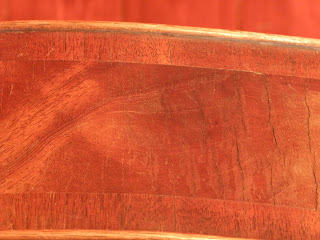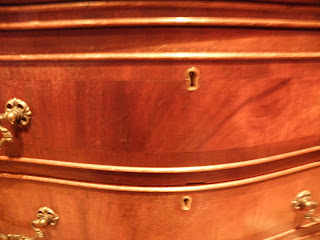A culture of wingless fruit flies
arrived in today's post (food for the mantids), and with it half a
dozen Thailand Marbled stick insects (Parapachymorph zomproi). These are
large, lovely insects - beautifully mottled with long, thorny limbs. They feed primarily on bramble leaves. This species is unusual in that the eggs hatch relatively quickly for stick insects, usually between two to eight weeks.
One specimen had lost a leg in transit, but this isn't a problem, as stick insects can regrow limbs. Strangely, it has been recorded that some insects have re-grown legs to replace lost antennae!
 |
| Remember, this is a nymph, and has more growing to do. |
 |
| Look at those lovely, long legs. |
 |
| Back in her home. |
I gave the plant stand another lick of paint, then varnished the beading on The Stage. Here's how it looks now.
The rest of the day was spent on the bureau. This is a weird bit of furniture. Bits of it scream quality but other things don't seem to fit. I don't know what to make of it. The first thing most people check out when appraising a piece of furniture is usually the drawers. In the plural. You should look at each drawer and confirm that they all match. If they do, then good. You can move on to examine one drawer in greater detail. The wood used in the inside of the drawer probably won't be the same wood as the drawer front - it's most likely to be oak or pine. Look at the joints. A better made piece will have better joints. This bureau has dovetail joints - which is a good sign.
Turn the drawer over and look at the bottom - are there signs of wear or worm? Another good sign under the drawer is that the bottom is held in place with small brass screws. A cheaper piece would have been pinned or glued rather than screwed. There is no sign of asymmetrical wear, which would indicate the drawer has been sticking, and could have been forced (which would weaken the joints).
But the front of the drawer is plywood, with a veneer facing. In a good quality piece, it ought to be solid wood. Why is it ply? This points to a cheaper construction. Then, paradoxically, the veneer on the exterior of the drawer is cross-banded ( look at a picture of the drawer front. The central veneer panel is bounded by a frame of veneer cut and laid at ninety degrees to the central panel). Again, cross banding is normally an indication of quality - it takes longer to lay, and requires a higher level of veneering skill.
The veneer on the right hand side of the drawer is cracked. It's not too bad, and is not coming away, but this is probably due to one of two causes. Maybe the bureau has been standing in direct sunlight. However, the colour is consistent, so this is unlikely; sunlight would have caused bleaching. The other alternative is central heating. I suspect the bureau has been placed near a heat source, which has dried the veneer unevenly, causing it to split. I gave it a good feed of almond oil, and will use a mixture of beeswax, turpentine and linseed oil later, to further enrich the wood.
One of the drawer handles is missing, so I swap over one from the door front. And again, if you look at the inside of the door, you can see the nuts holding the handles in place are covered with metal caps (as are the ones in the drawer). Yet again, a mark of a better piece. It would be normal to just leave the nuts exposed, but someone has gone to the trouble and expense of adding metal caps.
I cleaned and waxed the whole bureau, and as a finish touch, replaced the missing keyhole escutcheons. I used a hide mallet to knock them home, so as not to mark the surface of the wood.
Here's how it looks now.








Please tell me you are not bringing those things for the boys?? They look MASSIVE!! Yikes xcx
ReplyDelete